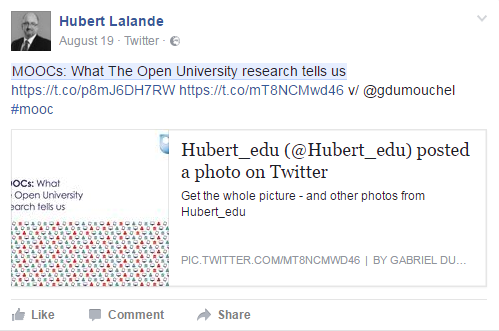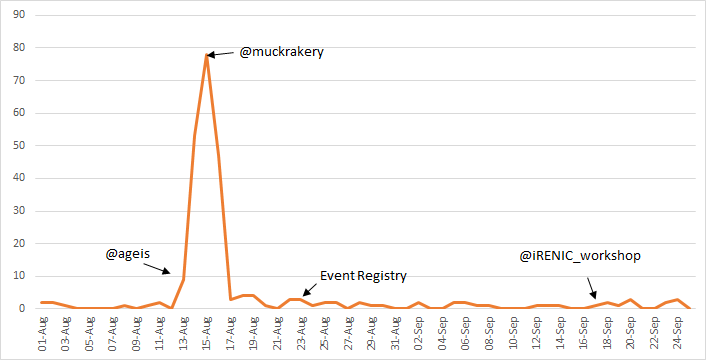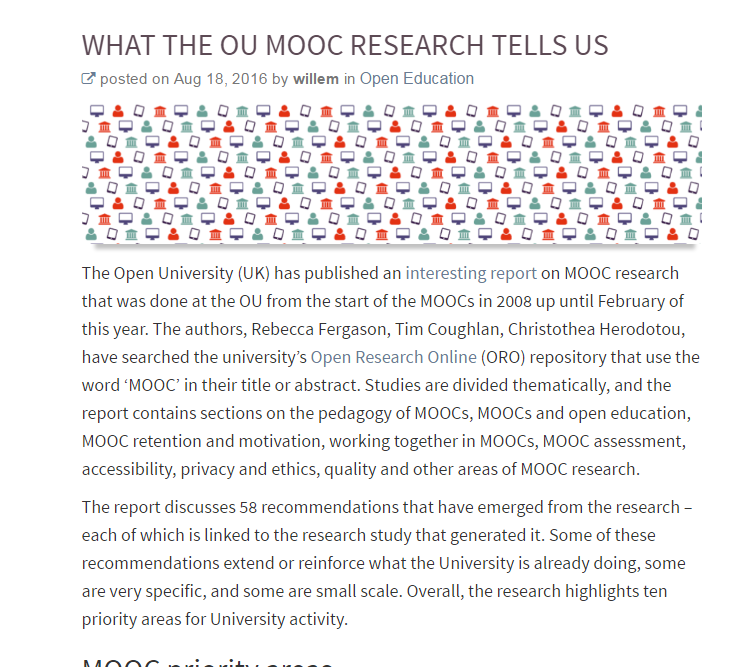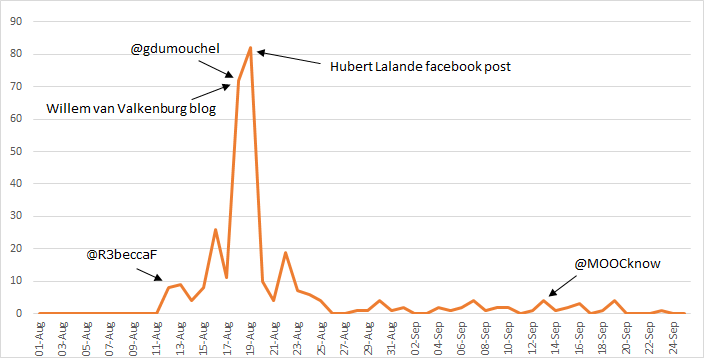The impact of engaging with social media in conjunction with Open Access papers in a repository is not new and was perhaps first illustrated by Melissa Terras back in 2012 in her blog post Is blogging and tweeting about research papers worth it? The Verdict where she writes:
“The papers that were tweeted and blogged had at least more than 11 times the number of downloads than their sibling paper which was left to its own devices in the institutional repository. QED, my friends. QED.”
When I review the top downloads of publications in ORO every month I see papers that have received more downloads than usual and I can attempt to see why that might be. Some months we can see how the presence of research outputs in MOOCs or OU modules increases the number of downloads of research publications. But this month there are 2 striking examples of how social media impacts the dissemination of research publications.
The top 50 downloads from August are listed below:
The first output that interested me was at Number 6: Ferguson, Rebecca; Coughlan, Tim and Herodotou, Christothea (2016). MOOCS: What The Open University research tells us. Institute of Educational Technology, The Open University, Milton Keynes. This received 305 downloads and had only been added to the repository on the 12th August this year. First analysis revealed that 12% of referrals in August were from Twitter and another 12% from Facebook (33% were internal ORO referrals and another 19% were from Google). So something had happened on Twitter and Facebook that helped cause a spike in downloads of the item.
So, the first trace of twitter activity was from Rebecca Ferguson (@R3beccaF) herself on 12th August:
MOOCs: What the @OpenUniversity Research Tells Us – report written for #OU audience but also available externally https://t.co/NRXNw1Fisc
— Dr Rebecca Ferguson (@R3beccaF) August 12, 2016
This was followed by another tweet by Gabriel Dumouchel (@gdumouchel) on the 18th August:
MOOCs: What The Open University research tells us https://t.co/KboeSdNKvw #MOOC #elearning #HigherEd #edtech pic.twitter.com/Zrdg6mhqjy
— Gabriel Dumouchel, Ph.D. (@gdumouchel) August 18, 2016
A blogpost by Willem van Valkenburg was also published on the same day
and a Facebook post by Hubert Lalande on the 19th:  Finally, there was a tweet on 13th September by MOOC Knowledge (@MOOCknow):
Finally, there was a tweet on 13th September by MOOC Knowledge (@MOOCknow):
#MOOCs: What the @OpenUniversity #Research Tells Us https://t.co/Z63211uZc3 #report #OU via @R3beccaF
— MOOC Knowledge (@MOOCknow) September 13, 2016
And if you map that activity against the daily download log, this is what you get:
The second item to grab my attention was at Number 12: Gray, Joshua; Franqueira, Virginia N. L. and Yu, Yijun (2016). Forensically-Sound Analysis of Security Risks of using Local Password Managers. In: 1st International Workshop on Requirements Engineering for Investigating and Countering Crime, 13 September 2016, Beijing, IEEE. This had been added to ORO on the 26th July and received 200 downloads during August. The referrals were even more intriguing as nearly half (48%) were from Twitter (a further 18% were internal and 11% were from Google)… so to the twitter trail.
On 13th August the ORO record was tweeted by K.M.Gallagher (@ageis):
PDF: Forensically-sound analysis of security risks of using local password managers https://t.co/1RaBBsDoi3 pic.twitter.com/QsnMkYTL24
— Kevin Gallagher (@ageis) August 14, 2016
Followed on the 15th by Brandon Smith (@muckrakery) with a response from Julia Angwin (@JuliaAngwin)
Jesus. @JuliaAngwin https://t.co/w6y33Kf4YQ
— Brandon Smith (@muckrakery) August 15, 2016
It was also posted on EventRegistry on 23rd August:
![]() Finally, it was tweeted by the conference organiser (@iRENIC_workshop) as Best Long paper (but with no link!)
Finally, it was tweeted by the conference organiser (@iRENIC_workshop) as Best Long paper (but with no link!)
"Forensically-Sound Analysis of Security Risks of using Local Password Managers" by Gray, Franquieira and Yu was awarded Best Long paper.
— iRENIC (@iRENIC_workshop) September 17, 2016
and if you map all that activity onto the daily downloads this is what you get:
 OK, so my trawl through the social media isn’t exhaustive – I’m sure there are activities I’ve missed, but I think it’s still instructive:
OK, so my trawl through the social media isn’t exhaustive – I’m sure there are activities I’ve missed, but I think it’s still instructive:
- Using social media can have an enormous impact on the reach of an Open Access publication
- The greatest dissemination of a research output may not be the result of an author (or co-authors) intervention in social media – but someone completely off the radar.
- Twitter and Facebook usage can both impact on the reach of any particular research output, they aren’t mutually exclusive and both serve the required function.
- Not all tweets are equal, some are more valuable than others.
- … and always add a link to the paper!
Finally, looking at the tweets and posts I was struck at how those that had the most impact on downloads were also the most eye-catching. These were tweets with photos of the abstract of the conference item or posts with the cover of the MOOC report. The images certainly makes them stand out in the timeline and there is some thinking to suggest tweets with images and links are more likely to get noticed.



